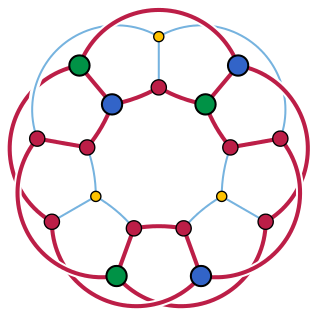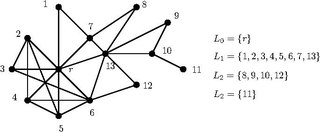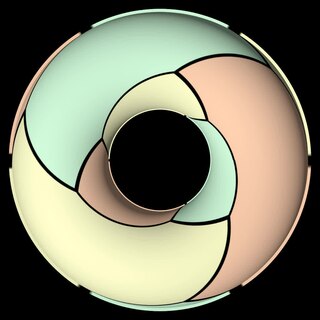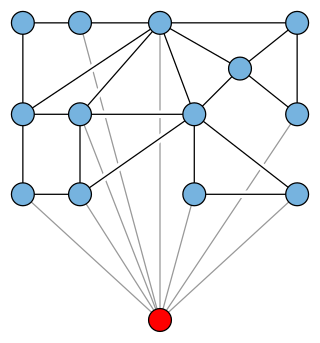Related Research Articles
In graph theory, a planar graph is a graph that can be embedded in the plane, i.e., it can be drawn on the plane in such a way that its edges intersect only at their endpoints. In other words, it can be drawn in such a way that no edges cross each other. Such a drawing is called a plane graph or planar embedding of the graph. A plane graph can be defined as a planar graph with a mapping from every node to a point on a plane, and from every edge to a plane curve on that plane, such that the extreme points of each curve are the points mapped from its end nodes, and all curves are disjoint except on their extreme points.

Robert Endre Tarjan is an American computer scientist and mathematician. He is the discoverer of several graph theory algorithms, including his strongly connected components algorithm, and co-inventor of both splay trees and Fibonacci heaps. Tarjan is currently the James S. McDonnell Distinguished University Professor of Computer Science at Princeton University.

In graph theory, Kuratowski's theorem is a mathematical forbidden graph characterization of planar graphs, named after Kazimierz Kuratowski. It states that a finite graph is planar if and only if it does not contain a subgraph that is a subdivision of or of .
In graph theory, an undirected graph H is called a minor of the graph G if H can be formed from G by deleting edges, vertices and by contracting edges.

In the mathematical theory of directed graphs, a graph is said to be strongly connected if every vertex is reachable from every other vertex. The strongly connected components of an arbitrary directed graph form a partition into subgraphs that are themselves strongly connected. It is possible to test the strong connectivity of a graph, or to find its strongly connected components, in linear time (that is, Θ(V + E)).

In the mathematical subfield of graph theory a level structure of an undirected graph is a partition of the vertices into subsets that have the same distance from a given root vertex.

In mathematics, topological graph theory is a branch of graph theory. It studies the embedding of graphs in surfaces, spatial embeddings of graphs, and graphs as topological spaces. It also studies immersions of graphs.
In graph theory, a biconnected component is a maximal biconnected subgraph. Any connected graph decomposes into a tree of biconnected components called the block-cut tree of the graph. The blocks are attached to each other at shared vertices called cut vertices or separating vertices or articulation points. Specifically, a cut vertex is any vertex whose removal increases the number of connected components.
In the mathematical field of graph theory, Fáry's theorem states that any simple, planar graph can be drawn without crossings so that its edges are straight line segments. That is, the ability to draw graph edges as curves instead of as straight line segments does not allow a larger class of graphs to be drawn. The theorem is named after István Fáry, although it was proved independently by Klaus Wagner (1936), Fáry (1948), and Sherman K. Stein (1951).

In topological graph theory, an embedding of a graph on a surface is a representation of on in which points of are associated with vertices and simple arcs are associated with edges in such a way that:

In graph theory, a branch of mathematics, the triconnected components of a biconnected graph are a system of smaller graphs that describe all of the 2-vertex cuts in the graph. An SPQR tree is a tree data structure used in computer science, and more specifically graph algorithms, to represent the triconnected components of a graph. The SPQR tree of a graph may be constructed in linear time and has several applications in dynamic graph algorithms and graph drawing.
A program structure tree (PST) is a hierarchical diagram that displays the nesting relationship of single-entry single-exit (SESE) fragments/regions, showing the organization of a computer program. Nodes in this tree represent SESE regions of the program, while edges represent nesting regions. The PST is defined for all control flow graphs.
Planarity is a 2005 puzzle computer game by John Tantalo, based on a concept by Mary Radcliffe at Western Michigan University. The name comes from the concept of planar graphs in graph theory; these are graphs that can be embedded in the Euclidean plane so that no edges intersect. By Fáry's theorem, if a graph is planar, it can be drawn without crossings so that all of its edges are straight line segments. In the planarity game, the player is presented with a circular layout of a planar graph, with all the vertices placed on a single circle and with many crossings. The goal for the player is to eliminate all of the crossings and construct a straight-line embedding of the graph by moving the vertices one by one into better positions.
In graph theory, a branch of mathematics, many important families of graphs can be described by a finite set of individual graphs that do not belong to the family and further exclude all graphs from the family which contain any of these forbidden graphs as (induced) subgraph or minor.
In graph theory, the planar separator theorem is a form of isoperimetric inequality for planar graphs, that states that any planar graph can be split into smaller pieces by removing a small number of vertices. Specifically, the removal of vertices from an n-vertex graph can partition the graph into disjoint subgraphs each of which has at most vertices.

In graph theory, a branch of mathematics, a cycle basis of an undirected graph is a set of simple cycles that forms a basis of the cycle space of the graph. That is, it is a minimal set of cycles that allows every even-degree subgraph to be expressed as a symmetric difference of basis cycles.

In graph theory, a branch of mathematics, an apex graph is a graph that can be made planar by the removal of a single vertex. The deleted vertex is called an apex of the graph. It is an apex, not the apex because an apex graph may have more than one apex; for example, in the minimal nonplanar graphs K5 or K3,3, every vertex is an apex. The apex graphs include graphs that are themselves planar, in which case again every vertex is an apex. The null graph is also counted as an apex graph even though it has no vertex to remove.
In graph drawing, a universal point set of order n is a set S of points in the Euclidean plane with the property that every n-vertex planar graph has a straight-line drawing in which the vertices are all placed at points of S.
In graph theory, a bipolar orientation or st-orientation of an undirected graph is an assignment of a direction to each edge that causes the graph to become a directed acyclic graph with a single source s and a single sink t, and an st-numbering of the graph is a topological ordering of the resulting directed acyclic graph.
In the mathematical field of graph theory, planarization is a method of extending graph drawing methods from planar graphs to graphs that are not planar, by embedding the non-planar graphs within a larger planar graph.
References
- ↑ Hopcroft, John; Tarjan, Robert E. (1974), "Efficient planarity testing", Journal of the Association for Computing Machinery , 21 (4): 549–568, doi:10.1145/321850.321852, hdl: 1813/6011 , S2CID 6279825 .
- ↑ Mehlhorn, Kurt; Mutzel, Petra (1996), "On the Embedding Phase of the Hopcroft and Tarjan Planarity Testing Algorithm" (PDF), Algorithmica, 16 (2): 233–242, doi:10.1007/bf01940648, hdl: 11858/00-001M-0000-0014-B51D-B , S2CID 10014462
- ↑ Mehlhorn, Kurt; Mutzel, Petra; Näher, Stefan (1993), An Implementation of the Hopcroft and Tarjan Planarity Test and Embedding Algorithm
- ↑ Mehlhorn, Kurt; Näher, Stefan (1995), "LEDA: A library of efficient data types and algorithms", Communications of the ACM, 38 (1): 96–102, CiteSeerX 10.1.1.54.9556 , doi:10.1145/204865.204889, S2CID 2560175
- ↑ Taylor, Martyn G. (2012). Planarity Testing by Path Addition (Ph.D.). University of Kent. Archived from the original on 2016-03-05. Alt URL
- ↑ Lempel, A.; Even, S.; Cederbaum, I. (1967), "An algorithm for planarity testing of graphs", in Rosenstiehl, P. (ed.), Theory of Graphs, New York: Gordon and Breach, pp. 215–232.
- ↑ Even, Shimon; Tarjan, Robert E. (1976), "Computing an st-numbering", Theoretical Computer Science, 2 (3): 339–344, doi: 10.1016/0304-3975(76)90086-4 .
- ↑ Boyer & Myrvold (2004), p. 243: “Its implementation in LEDA is slower than LEDA implementations of many other O(n)-time planarity algorithms.”
- ↑ Chiba, N.; Nishizeki, T.; Abe, A.; Ozawa, T. (1985), "A linear algorithm for embedding planar graphs using PQ–trees", Journal of Computer and System Sciences, 30 (1): 54–76, doi: 10.1016/0022-0000(85)90004-2 .
- ↑ Shih, W. K.; Hsu, W. L. (1999), "A new planarity test", Theoretical Computer Science, 223 (1–2): 179–191, doi: 10.1016/S0304-3975(98)00120-0 .
- ↑ Boyer, John M.; Myrvold, Wendy J. (2004), "On the cutting edge: simplified O(n) planarity by edge addition" (PDF), Journal of Graph Algorithms and Applications , 8 (3): 241–273, doi: 10.7155/jgaa.00091 .
- ↑ de Fraysseix, H.; Ossona de Mendez, P.; Rosenstiehl, P. (2006), "Trémaux Trees and Planarity", International Journal of Foundations of Computer Science, 17 (5): 1017–1030, arXiv: math/0610935 , Bibcode:2006math.....10935D, doi:10.1142/S0129054106004248, S2CID 40107560 .
- ↑ Brandes, Ulrik (2009), The left-right planarity test (PDF).
- ↑ Boyer, John M.; Cortese, P. F.; Patrignani, M.; Battista, G. D. (2003), "Stop minding your P's and Q's: implementing a fast and simple DFS-based planarity testing and embedding algorithm", Proc. 11th Int. Symp. Graph Drawing (GD '03), Lecture Notes in Computer Science, vol. 2912, Springer-Verlag, pp. 25–36
- ↑ Chimani, M.; Mutzel, P.; Schmidt, J. M. (2008). "Efficient extraction of multiple Kuratowski subdivisions". Proc. 15th Int. Symp. Graph Drawing (GD'07). Lecture Notes in Computer Science. Vol. 4875. Sydney, Australia: Springer-Verlag. pp. 159–170. doi:10.1007/978-3-540-77537-9_17. ISBN 978-3-540-77536-2..
- 1 2 "OGDF - Open Graph Drawing Framework: Start".
- ↑ "Boost Graph Library: Boyer-Myrvold Planarity Testing/Embedding - 1.40.0".
- ↑ Williamson, S. G. (1984), "Depth First Search and Kuratowski Subgraphs", Journal of the ACM, 31 (4): 681–693, doi: 10.1145/1634.322451 , S2CID 8348222
- ↑ Schmidt, Jens M. (2014), "The Mondshein Sequence", Automata, Languages, and Programming; Proceedings of the 41st International Colloquium on Automata, Languages and Programming (ICALP'14), Lecture Notes in Computer Science, vol. 8572, pp. 967–978, doi:10.1007/978-3-662-43948-7_80, ISBN 978-3-662-43947-0
- ↑ La Poutré, Johannes A. (1994), "Alpha algorithms for incremental planarity testing", Proceedings of the Twenty-Sixth Annual ACM Symposium on Theory of Computing (STOC), pp. 706–715, doi:10.1145/195058.195439, S2CID 16799743
- ↑ Di Battista, Giuseppe; Tamassia, Roberto (1996), "on-line maintenance of triconnected components with SPQR-trees", Algorithmica, 15 (4): 302–318, doi:10.1007/BF01961541, S2CID 7838334
- ↑ Tamassia, Roberto (1996), "On-line planar graph embedding", Journal of Algorithms, 21 (2): 201–239, doi:10.1006/jagm.1996.0044
- ↑ Westbrook, Jeffery (1992), "Fast Incremental Planarity Testing", Automata, Languages and Programming, 19th International Colloquium, ICALP92, doi:10.1007/3-540-55719-9_86
- ↑ Pătrașcu, Mihai; Demaine, Erik (2004), "Lower Bounds for Dynamic Connectivity", Proceedings of the Fourteenth Annual ACM-SIAM Symposium on Discrete Algorithms, pp. 546–553, doi:10.1145/1007352.1007435, ISBN 1581138520, S2CID 2121130
- ↑ Holm, Jacob; Rotenberg, Eva (2020). "Fully-dynamic planarity testing in polylogarithmic time". In Makarychev, Konstantin; Makarychev, Yury; Tulsiani, Madhur; Kamath, Gautam; Chuzhoy, Julia (eds.). Proceedings of the 52nd Annual ACM SIGACT Symposium on Theory of Computing, STOC 2020, Chicago, IL, USA, June 22-26, 2020. Association for Computing Machinery. pp. 167–180. arXiv: 1911.03449 . doi:10.1145/3357713.3384249.
- ↑ Eppstein, David; Galil, Zvi; Italiano, Giuseppe; Spencer, Thomas (1996), "Separator based sparsification: I. planarity testing and minimum spanning trees", Journal of Computer and System Sciences, doi: 10.1006/jcss.1996.0002
- ↑ Galil, Zvi; Italiano, Giuseppe; Sarnak, Neil (1999), "Fully dynamic planarity testing with applications", Journal of the ACM, 46: 28–91, doi: 10.1145/300515.300517 , S2CID 7009330